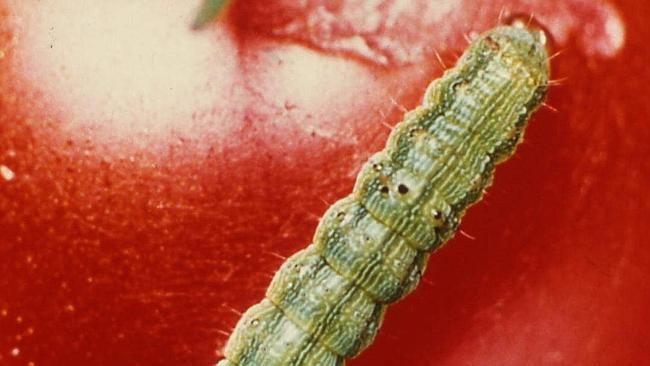Garden tips: tomato grub; agapanthus; ground cover; pomegranate
Something eating your tomatoes and it’s not you? Suspect a very hungry caterpillar.

Something is eating my tomatoes and it’s not me. There are small, round holes but no caterpillars visible on top. I tried the usual sprays.
DONNA ROBERTS, PERTH
Tomato grub, pictured, also called budworm, bores holes into fruit, where they are largely protected from any sprays you apply. Covering crops with fine mesh fabric prevents the moths laying eggs on the plants; some vegie nets also protect against fruit fly. Dipel is an organic solution, a natural bacterium that affects only caterpillars. Spray weekly on to flowers and leaves so grubs ingest it when newly hatched, before they burrow into fruit.
The pink agapanthus seeds we bought at considerable expense through a private seller online have started flowering but unfortunately are just common blue. Have we any redress with the seller?
ROBERT KEANE, BRISBANE
Ask the seller for a refund and, if not satisfied, use that website’s rating system against that seller. Pink is a rare colour for agapanthus; seeds are unlikely to be true so you’d need to buy offsets to guarantee their colour. ‘Roseus’ and ‘Strawberry Ice’ are closest to pink but are blush pink across white at best. They’re both slow-growing and have low seed set. The photo of pink agapanthus displayed by that seller is not an agapanthus but unrelated Armeria.
To reduce weeds I favour close planting and ground covers, rather than poisoning weeds, leaving empty spaces. Can you recommend suitable ground covers for large spaces, with predominantly clay soil?
HELEN MACKANZIE, SYDNEY
In shady areas try Asiatic star jasmine (Trachelospermum asiaticum), Vinca minor and Vinca major ‘Variegata’, or native violet in moist shade. In full sun, if drainage is adequate, try gazanias, prostrate grevilleas, creeping boobialla (Myoporum parvifolium), and baby sun rose (Aptenia cordifolia). In part shade, bellflower (Campanula poscharskyana) and Spanish shawl (Heterocentron elegans) are colourful.
I have a potted pomegranate and a persimmon. When should I transplant them into the ground? What conditions do they like? Do either have invasive roots?
JENNIFER FOONG, SYDNEY
The ideal times for planting are spring and autumn but you can plant any time if you water enough. Neither has invasive roots but persimmons are spreading trees that need a wide space. Both need full sun and well-drained soil.
Send questions to: helenyoungtwig@gmail.comor Helen Young, PO Box 3098, Willoughby North, NSW 2068. Website: helenyoung.com.au. The best question for December wins a signed copy of The Australian Native Garden by Angus Stewart and AB Bishop, worth $50.
FLORA: Excuse me, but it’s time to talk flowers and sex. Zucchinis, cucumbers, squash and pumpkins are starting to flower, bearing separate male and female flowers along the vines. If there aren’t plenty of bees to transfer pollen from male flowers to inseminate female flowers then you won’t get a crop. A helping hand in the morning works wonders. Male flowers have a longer stalk between the flower and stem. Use a small artist’s brush to collect pollen from the centres and gently tickle it into the centres of the female flowers. These tend to have a bulbous swelling at the base and short stalks. The result is fertilisation — not to be confused with fertilising. Unfertilised female flowers can form a tiny fruit but these soon drop off before developing.



